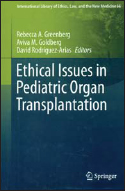Translate this page into:
Ethical Issues in Pediatric Organ Transplantation
Corresponding Author:
| How to cite this article: Timms O. Ethical Issues in Pediatric Organ Transplantation. Natl Med J India 2017;30:172 |
Ethical Issues in Pediatric Organ Transplantation. Rebecca A. Greenberg, Aviva M. Goldberg, David Rodriguez-Arias (eds). Springer, Basel, 2016. 340pp, ₹6134. ISBN 978–3–319–29183–3.

Ever since progress in medical science made organ transplantation possible in humans, this area of healthcare has been the focus of controversy and ethical dilemma, which have convulsed not only the health community but patients and society as well. A treatment that has saved lives and brought immeasurable benefits has raised ethical and justice issues which strike at the heart of our humanness and being. In India, there is the added dimension of human exploitation in organ transplant that led to government interventions in this area, through stringent and often crippling regulations.
Advancements in the field made paediatric organ transplantation possible, bringing with it unique medical complexities and ethical challenges. The vulnerability of children and child donors calls for additional safety and responsibility, including discernment in matters related to surrogate decision-making. In developing countries, among socioeconomically disadvantaged populations, this vulnerability is compounded. In India, paediatric organ transplantation (renal, liver and recently heart) has been a reality since the late 1980s, but bioethical literature in this area has lagged behind.
The editors of this book are eminently qualified and suited to developing a resource publication in this area. Rebecca Greenberg is a bioethicist from Canada who has worked with children; Aviva Goldberg, a leading paediatric nephrologist; and David Rodriguez- Arias, a philosopher, all located in North America. They have acknowledged this book as a ‘labour of love’ driven by their ‘passion for ethics and transplantation’. The editors have pulled together some of the best minds on the subject, including intensivists, nephrologists, surgeons, paediatricians, ethicists, lawyers and philosophers. The authors have in-depth experience in paediatric transplant and offer a rare exploration of the width and poignancy of ethical issues encountered in this specialized area, even offering policy and advice gleaned from their efforts in the field. Voices from the book have highlighted issues across the mediscape of paediatric organ transplantation, offering the reader a comprehensive understanding of sensitive areas, unresolved issues and social dilemmas. Topics range from challenges in obtaining and allocation of organs, to dealing with patient families and consent. It speaks of the ever-widening demand and supply gap, due to advances in medical science that allow for transplantation even in complicated cases. Are available organs considered to be the resource of the individual? Or the resource of society in which they live? Health professionals are caught on the horns of this dilemma as they seek the best outcome for their precious young patients, amidst regulations, policy and guidelines, responsibility to society and practical constraints.
Allowing space for diverse views, the editors have carefully grouped the contributions into five parts based on broad topics, for better understanding. Under ‘Living donation’, the authors question whether children should be living donors and how to address paternity issues that may arise. The section on ‘Deceased donation’ looks at the limits on persuading families to donate organs of family members, death determination in children and the newborn as an organ donor. ‘Emerging challenges’ addresses ethical issues in paediatric small bowel transplantation and managing conflicts in the era of social media. In ‘Allocating organs’ the authors present new criteria for solid organ transplant eligibility and question if organs should be offered to foreign nationals. Finally, in ‘Recipient issues’, the uncertainty of risk in paediatric heart transplant is discussed, as well as psychosocial evaluation of paediatric transplant candidates and care of the paediatric transplant recipient.
This book is strongly recommended for professionals working in the area of paediatric organ transplantation. It offers a theoretical and practical overview of the unique ethical, practical and legal issues in paediatric transplantation, as intended by the editors. Topics are scholarly and well researched, elegantly presented, with the scientific rigor of an academic publication. The 300-page read may appear daunting, but one is soon drawn into the deeply human controversies and painful medical dilemmas. For regions outside North America, where the discipline of bioethics is still growing, this book will contribute to building awareness and anticipating problems in this field with a view to instituting policy and protection of a vulnerable paediatric population. Access to the publication should not be difficult, given the wide presence of Springer, online and offline. Though the price of the hardbound copy may be high, an e-version is available.
Fulltext Views
629
PDF downloads
204




